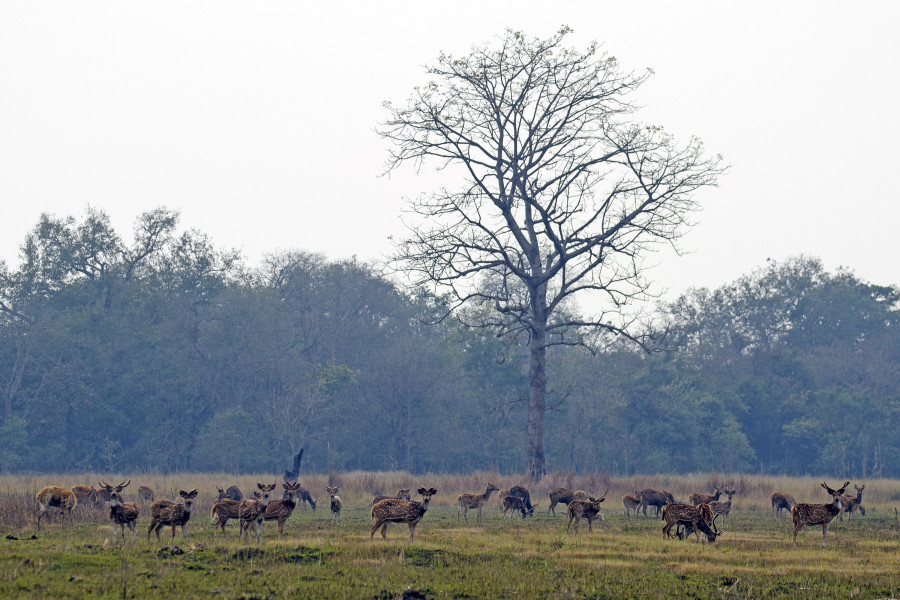Climate & Environment
Surreal landscapes and abundant wildlife await visitors at Shuklaphanta National Park
Tucked away in the south-western corner of Nepal, this park is famed for its abundance of deer, tigers, rhinos and other exotic species.
Bhawani Bhatta
Shuklaphanta National Park is composed of surreal landscapes—expansive grasslands vie for dominance with dense forests and tropical wetlands. A rangale of deer, a streak of tigers , a flight of butterflies—all tread the same spaces. This untouched wilderness, spread out over 305 square kilometres north of India’s Lagga-Bagga and east of the mighty Mahakali, is Nepal’s best-kept secret.
Established as a national park in 1976, Shuklaphanta is the country’s second youngest national park, after Parsa National Park. Located in the south-western corner of Nepal in the Sudurpaschim province, this park was once a hunting reserve, famed for its abundance of deer, tigers, rhinos and other exotic species. Ever since its conversion into a national park, its animal, bird and fish species have multiplied. The park is now home to 2,500 swamp deer, 17 tigers, as many rhinos, 12 species of reptiles, 20 species of amphibians, 424 bird species, 24 fish species 35 species of butterflies; the flora extends to 665 plant species from 118 different families. Rare bird species like the Lesser Adjutant, Bengal Florican, White-rumped Vulture, Sarus Crane, and Finn’s Weaver also make for exciting bird watching.
However, this park has often been eclipsed by other, more popular reserves, especially the Chitwan National Park. Most tourists, both local and foreign, are not even aware of the park’s existence, let alone its abundance of flora and fauna. Only about 2,000 to 2,500 people visit the park annually. But perhaps that is its charm. Away from the madding crowd, this park offers untouched wilderness and serenity.
One of the few patrons who made their way to the park last year, former Finnish ambassador to Nepal Jorma Suvanto, likened the park’s grasslands to the Savanna, Africa’s massive tropical grassland.
“This is untouched territory,” said Suvanto. “Those who come to Nepal must visit Shuklaphanta. I’ll advise tourists from my own country to pay a visit to Nepal and the Shuklaphanta National Park.”
The park lies close to the Indian border and thus is located strategically close to popular Indian national parks like the Dudhwa and Jim Corbett national parks. India’s Kishanpur Wildlife Sanctuary, an specially designated tiger reserve, lies contiguous to the south of Shuklaphanta, together making up 439 square kilometres of a protected tiger conservation unit. Shuklaphanta is also part of the Tarai Arc Landscape, 5 million hectares of protected land from both India and Nepal.
Despite this proximity to the Indian border and its teeming wildlife, the park hosts comparatively fewer visitors.
“Of course, you have national parks that may offer more but Shuklaphanta offers you one thing that others don’t—a personal space you can share with nature,” said Ravi Kc, a Kathmandu-based entrepreneur who was visiting Shuklaphanta this March. “It makes you feel as if you’re the only one who is given the privilege to enjoy nature in its full glory. And there is just so much to do here. ”

Tourism entrepreneurs are of the opinion that a lack of publicity and inadequate transportation and accommodation options are hindering the park’s growth as a thriving tourist destination.
“Shuklaphanta is virgin territory in terms of tourism,” said KC. “That so few people visit is a blessing in disguise, but of course, the more people visit, the easier it will be for the park to sustain itself in the long-term.”
Laxman Prasad Paudel, chief conservation officer at the SNP, understands the importance of attracting more tourists to the park but also underscores the lack of infrastructure on the park’s premises.
“It’s good for the park to have visitors but we also have to look at our own capacity to host,” he said. “People come here for safaris but we only have a limited number of vehicles so we can entertain only a certain number of tourists at a time.”
Paramananda Bhandari, a Kanchanpur-based tourism entrepreneur, also pointed out that the Majhgaun Airport adjoining the park has been closed for some time now.
“The lack of air connectivity has contributed to the dwindling number of tourists at the park,” said Bhandari. “If the physical infrastructure is developed then I’m certain that the park will see more visitors.”
Infrastructural shortcomings aside, visitors say that the park is definitely worth a visit at least once in your lifetime. For visitors like KC, the best thing about the park is that you get to enjoy something outside of the mainstream, soak in every sight the park offers at leisure, because the one thing the park does best is that it makes you stop in your tracks and take notice of nature’s bounty around you.
Entry fee for Nepali citizens is Rs 100; SAARC nationals Rs 750 and Rs 1,500 for others. The closest airport is Geta Airport in Dhangadhi, Kailali, about 55 km from Shuklaphanta. There are numerous homestays around the national park that provide accomodation. The best time to visit is during April-May. Approximate costs are Rs 5,000 for Nepalis and Rs 8,000 for others, per day.




 8.12°C Kathmandu
8.12°C Kathmandu










